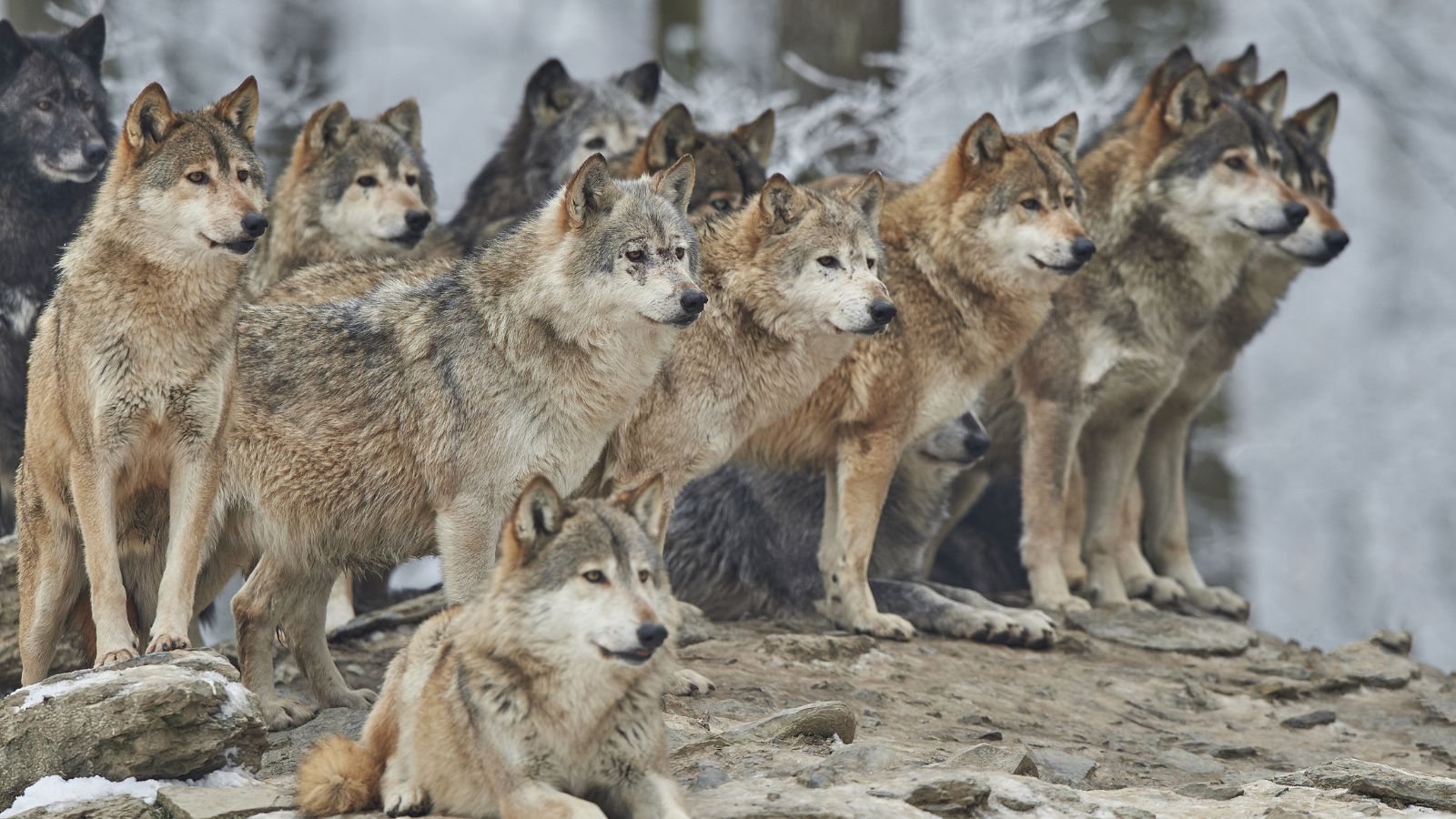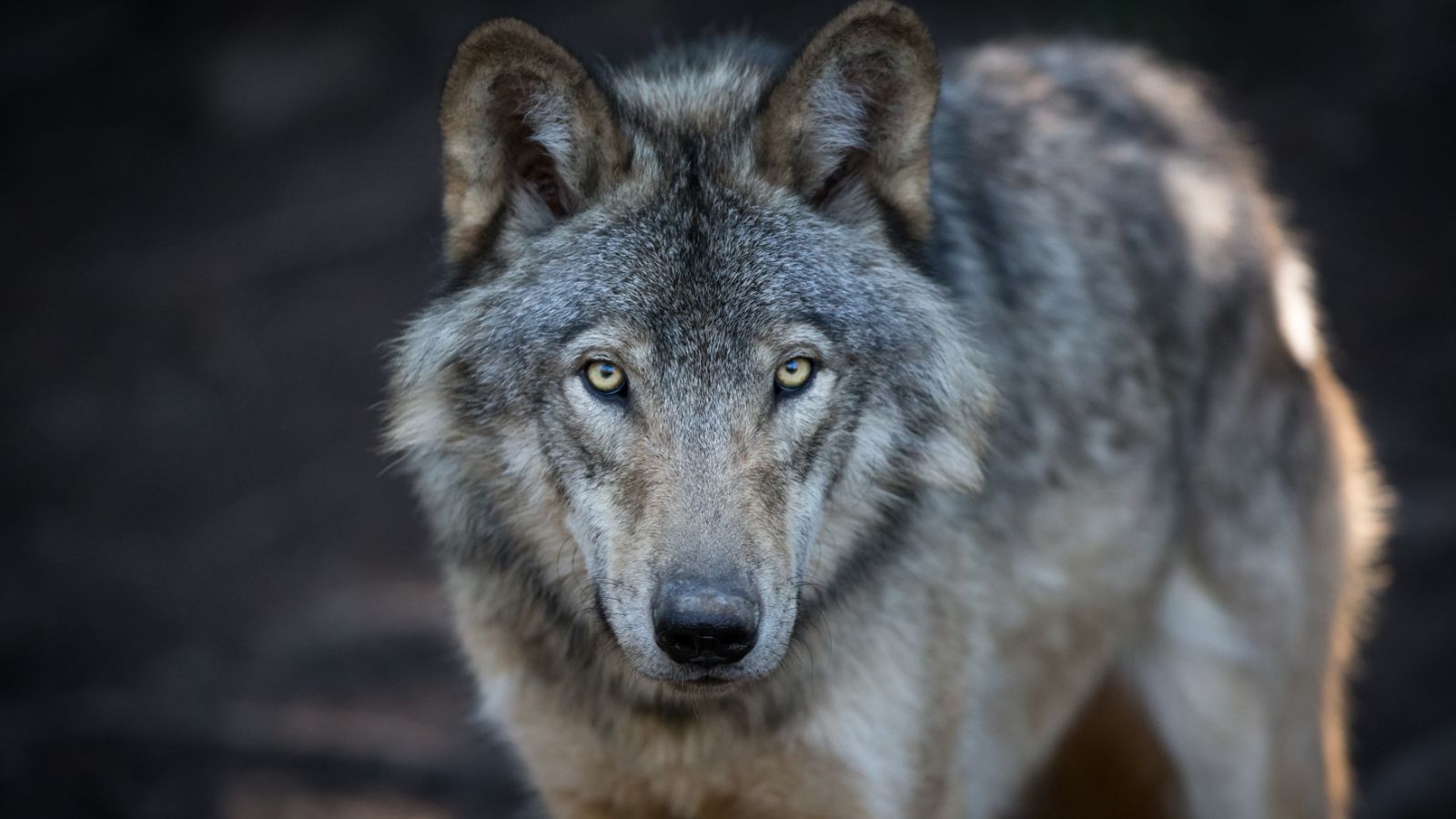Wolves are fascinating animals, with 38 subspecies worldwide, including domestic dogs. Highly intelligent, they live and hunt in packs and positively impact ecosystems as both apex predators and a keystone species. Here are 18 interesting facts about wolves.
Diet

Wolves are carnivores and pack hunters that primarily feed on large-hoofed mammals, or ungulates, and medium-sized mammals. In North America, they prey on caribou, elk, moose, mule deer, and white-tailed deer. However, they will also eat smaller animals, including rodents, hares, waterfowl, snakes, frogs, fish, and even fruit.
Pack Sizes

Wolf Haven International explains that “most packs have between four and ten members,” but they can range from two to 15 per pack. Packs range from smaller nuclear families to large extended families, which are more common in landscapes with higher numbers of both wolves and prey animals.
Reproduction

Wolves are monogamous, and mating pairs remain together for life. They become sexually mature at three years old, and female wolves can produce an average of one litter a year. Pregnancy lasts from around 62 to 75 days, and pups are usually born in the spring or early summer in colder environments.
Adaptations for Survival

Throughout history, wolves have evolved in different ways for survival. For example, their long legs allow them to run fast and travel far when searching for food, and their large skulls and jaws are adapted to catch and feed on various animals. Their fur is also oily to keep them dry, making them snowproof.
Conservation Status

The IUCN considers wolves a ‘Least Concern’ species, and their population decline stopped during the 1970s. However, they continue to be threatened by habitat fragmentation due to human activity.
Wolves in Folklore and Culture

Wolves appear in various cultures, including Native American and European myths, as both noble and malevolent figures. The Ancient Greeks associated them with the god of light and order, Apollo, while the Ancient Romans connected them with Mars, the god of agriculture and war.
Wolves and Ecosystem Health

Wolves are an essential part of their ecosystems, a “keystone species.” The California Wolf Center explains that, as a keystone species, other animals and plants within their ecosystems depend on them. When they were reintroduced to Yellowstone National Park from Canadian populations in the 1990s, they rebalanced elk and deer populations, which allowed aspen and willow to grow back. This led to stabilized riverbanks, rivers flowing in new directions, and beavers, foxes, eagles, and badgers returning.
Vocalizations

Wolves are known for their howls, but they also bark, growl, and whimper. They howl to assemble their packs before and after hunts, pass on alarms, and locate each other in unfamiliar territory. They bark when startled, growl during food challenges, and whine when curious or anxious.
Intelligence and Problem Solving

Wolves are known for their intelligence, and like elephants, dolphins, and gorillas, they will care for the members of their pack who are injured. They are more intelligent than domestic dogs, with some estimates considering them ten times more intelligent, and they consistently outperform dogs in problem-solving skills.
Territories

Wolves are known for establishing territories. DBBW explains that territories are the home range of adult wolves, “which they mark and defend against other wolves.” They mark their territory through howling, scent marks, and visual marks to let migrating wolves in other packs know that the territory is taken.
Apex Predators

Wolves are apex predators in various ecosystems around the world, such as in Yellowstone National Park, where they keep elk populations stable. Grizzly bears scavenge off their kills, along with coyotes, black bears, eagles, and ravens.
Origin of Domestic Dogs

Humans have had a complex relationship with wolves dating back millennia. Dogs diverged from an extinct population of wolves 27,000 to 40,000 years ago and were domesticated before humans kept boars, goats, and sheep.
Subspecies

The wolf, or Canis lupus, has 38 subspecies, including the domestic dog, dingo, Arctic wolf, red wolf, and Ethiopian wolf. Environmental and geographical factors have contributed to the genetic diversity of these different species as they adapted to various climates and available prey.
Communication

Wolves have a sophisticated communication style that domestic dogs have inherited. The International Wolf Center explains that “wolves use three different languages”—sound, scents, and body language. Sounds serve different purposes, including long-distance communication, alarm systems, and social bonding.
Wolves’ Role in Public Safety and Health

The presence of wolves can positively influence disease dynamics in wildlife populations by controlling disease-carrying animals like deer and rodents. They have also killed people, but these incidents are incredibly rare, many of them from rabid wolves.
Wolf Tracking and Research

Scientists and researchers track and study wolves using radio collars and trail cameras. These methods help them learn about how wolves travel, when they rest, what they eat, and how often they come into contact with human populations.
Wolves and Climate Change

Climate change affects animals in ecosystems worldwide, including wolves. Earlier winter thaws due to higher temperatures mean less winter carrion left by wolves for scavenger species that rely on them, like hawks, foxes, and vultures.
The Future of Wolves

Wolf populations worldwide are recovering. Over the past three decades, they have been reintroduced in several European countries and established healthy populations, and their population in America is stable.
Read More: 17 Things Society Can No Longer Do Because Gen Z Said So

Gen Z, our digital-native, trendsetting generation, is making waves in the cultural sea, steering the ship of societal norms in fresh and unexpected directions. As they charter new territories, there are certain practices they’d rather we say goodbye to. Curious? Let’s take a look at 17 things the rest of us can no longer do because Gen Z said so.
17 Things Society Can No Longer Do Because Gen Z Said So
19 Big Mistakes People Make After Losing a Spouse

Losing a spouse is one of life’s most tragic experiences, and when we’re overwhelmed by grief, we might make some decisions that we’ll later regret. Here are 19 mistakes people make after losing their spouse.
19 Big Mistakes People Make After Losing a Spouse
20 Time-Honored Practices Our Grandparents Followed That We Should Bring Back

Our grandparents had a far simpler life. There was no such thing as social media. Instead, there was more walking and meals were always fresh and homemade. With so many things keeping us busy nowadays, sometimes life would seem much easier if we lived the way our grandparents did.
20 Time-Honored Practices Our Grandparents Followed That We Should Bring Back
19 Common Behaviors of Highly Intelligent People

Intelligent individuals often display a range of behaviors and qualities that set them apart from others. When exploring these characteristics, it’s crucial to comprehend that intelligence is a multifaceted attribute. Here are 19 essential behaviors and qualities frequently observed in highly intelligent people.
19 Common Behaviors of Highly Intelligent People
17 Things We Were Taught in High School That We Now Know Aren’t True

Well, this one may depend on when you went to high school, but for this millennial, these are the things we were taught in high school that have been proven not to be true. Personally, I still want to go back and correct every teacher who told me I wouldn’t always have a calculator in my pocket; the joke is on them.
17 Things We Were Taught in High School That We Now Know Aren’t True

